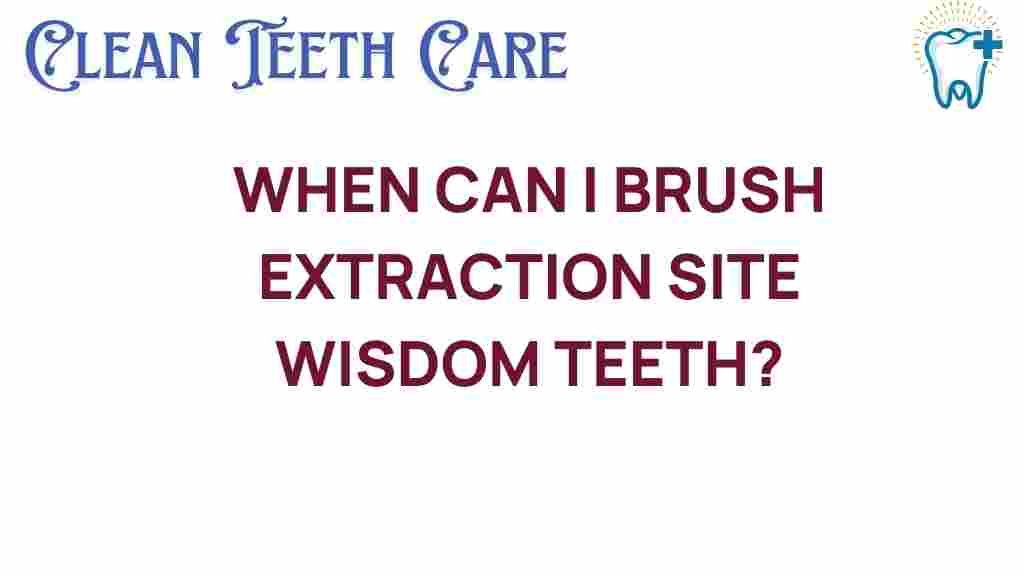When Is It Safe to Brush Your Wisdom Teeth Extraction Site?
Wisdom teeth extraction is a common procedure that many people undergo during their late teens or early twenties. While the surgery itself is relatively straightforward, the recovery process requires careful attention to oral care. One of the most common concerns after wisdom teeth removal is when it is safe to brush the extraction site. In this article, we will discuss the importance of dental hygiene during recovery, provide guidelines for post-operative care, and offer advice based on dentist advice to ensure optimal oral health.
The Importance of Oral Care After Wisdom Teeth Extraction
Following the extraction of wisdom teeth, maintaining good oral care is essential to prevent complications such as infection or dry socket. The extraction site requires special attention, and knowing when and how to brush is crucial for a smooth recovery.
Understanding the Healing Process
After your wisdom teeth are removed, your body begins the healing process. This typically involves:
- Formation of a blood clot at the extraction site
- Reduction of swelling and pain
- Gradual healing of the gum tissue
During the first few days post-surgery, the extraction site is particularly vulnerable, necessitating careful post-operative care to protect the area and promote healing.
When Can You Start Brushing After Wisdom Teeth Extraction?
Most dentists recommend waiting at least 24 hours after the extraction before starting to brush your teeth again. However, it’s important to follow specific guidelines to ensure that you do not disrupt the healing process. Here’s a step-by-step process to follow:
Step-by-Step Process for Brushing Post-Extraction
Day 1: Immediate Post-Extraction Care
On the first day after your wisdom teeth are extracted, avoid brushing your teeth altogether. Instead, focus on:
- Gently rinsing your mouth with warm salt water after meals
- Using a clean gauze pad to absorb any oozing blood
Day 2-3: Resuming Gentle Oral Hygiene
After 24 hours, you can begin to brush your teeth again, but with caution:
- Use a soft-bristled toothbrush to avoid irritating the extraction site.
- Brush the teeth that are not near the extraction site gently.
- Do not brush directly over the extraction site for the first few days.
Week 1: Gradually Resume Normal Brushing
By the end of the first week, if your healing is progressing well, you can start to brush the area around the extraction site more carefully:
- Brush gently around the extraction site without applying too much pressure.
- Continue using a soft-bristled toothbrush.
- If you experience pain or bleeding, stop brushing that area and consult your dentist.
After Week 1: Full Brushing Regimen
Usually, after one week, most patients can resume their regular brushing routine. However, always listen to your body:
- Once the extraction site has healed sufficiently and any stitches (if applicable) have been removed, you can brush normally.
- Continue to monitor for any signs of complications.
Additional Oral Care Tips for Recovery
To ensure optimal healing and maintain good dental hygiene, consider the following tips:
- Use an antibacterial mouthwash: This can help reduce bacteria in your mouth and promote healing.
- Stay hydrated: Drink plenty of fluids to keep your mouth moist and aid in recovery.
- Avoid certain foods: Stay away from hard, crunchy, or spicy foods that could irritate the extraction site.
- Follow your dentist’s instructions: Always adhere to the specific dentist advice given to you after your procedure.
Troubleshooting Common Issues
During your recovery, you may encounter some difficulties. Here are common issues and how to address them:
1. Bleeding
If you experience excessive bleeding after the first day, it may be a sign that the blood clot has been dislodged. In this case:
- Place a damp gauze pad on the site and bite down gently for 30 minutes.
- If bleeding persists, contact your dentist.
2. Swelling and Pain
Some swelling and discomfort are normal after extraction. To manage this:
- Apply an ice pack to the outside of your cheek for the first 24 hours.
- Take pain medication as prescribed by your dentist.
3. Dry Socket
Dry socket occurs when the blood clot fails to form or is dislodged. Symptoms include severe pain and an unpleasant taste. If you suspect dry socket:
- Contact your dentist immediately for treatment options.
Conclusion
Knowing when it is safe to brush your wisdom teeth extraction site is crucial for a smooth recovery. Following the outlined steps for post-operative care and maintaining good dental hygiene will significantly reduce the risk of complications. Always heed your dentist’s advice and consult them if you experience any unusual symptoms during your recovery. Your commitment to proper oral care during this period is vital for achieving optimal oral health in the long run.
For more information on maintaining good dental health, consider visiting the American Dental Association’s website. Remember, proper care after wisdom teeth extraction sets the foundation for a healthier mouth.
If you need personalized advice during your recovery, don’t hesitate to reach out to your dentist for guidance. Your oral health deserves the best care!
This article is in the category Treatments and created by CleanTeethCare Team
